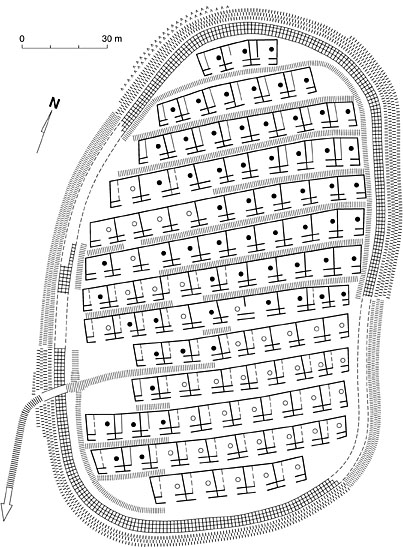

 | Page 163 |  |
houses laid out on a regular street system, and they may have housed up to 1,000 people. Each house interior was divided into two parts with the entrance fulfilling economic functions. Two phases of occupation have been distinguished, and 75 percent of the site has been excavated thus far.

Plan of Biskupin
The fortified settlement of Biskupin was found in 1933 and excavation began in 1934. Fieldwork was directed by józef kostrzewski and Zdzislaw Rajewski with the participation of Wojciech Kocka, Tadeusz Wieczorowski, Feliks Wydra, and Jozef Szubert. Excavations were carried out in the years 1934–1939, and when they resumed in 1946 after World War II, they continued until the 1960s. Various specialists from complementary disciplines participated: soil and geological studies (Feliks Terlikowski, Jozef Czekalski, Karol Paulo), palynological analyses (Adam Paszewski, Julian Witold Rafalski), archaeozoological studies (Edward Lubicz-Niezabitowski), botanical and dendrological studies (Bronislaw Jaron, Tadeusz Dominik), ethnographic research of the Biskupin architecture (Stanislaw Poniatowski), and others.
Photographic documentation of the site was very important. Wojciech Kocka developed the technique of taking pictures from a small balloon, and there were very successful attempts to produce color photographs as early as 1939. Research at Biskupin marked enormous progress in Polish archaeological studies. It was truly comprehensive, owing to the fruitful cooperation with specialists from other disciplines. This cooperation was characterized by real partnership, and it led to the development of new methods of excavation. The large scale of the research was also significant. After World War II, Biskupin was the place where practical courses on excavation methods for students of archaeology, history, and the history of art were organized. As a result, the great majority of students of that time gained their archaeological experiences in Biskupin.
Biskupin is now a well-known archaeological open-air museum. It was, and still is, an important center for experimental archaeology, especially in building, tillage, food preparation, stone and flint work, antler and bone work, wood and wool work, clay processing, and the obtaining of tar.
References
Rajewski, Zdzislaw. 1959. Biskupin: Polish Excavations [translation by Leopold Widymski]. Warsaw: Polonia.
Born in Minneapolis, Minnesota, Blegen excavated at Korakou, Prosymna, and Pylos in greece, but he is best known for his extensive excavations at Troy. Blegen was professor of classical archaeology at the University of Cincinnati, Ohio (1927–1957). As secretary of the american school of classical studies at athens, Blegen, along with Alan Wace, director of the British School in Athens, devised a chronology for mainland Greece for the Early, Middle, and Late Helladic periods through the pottery sequence from their excavation of the
 |  |